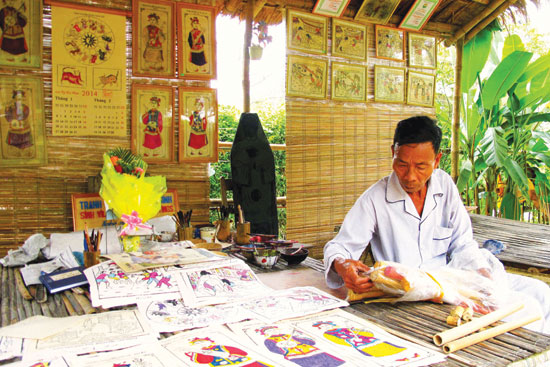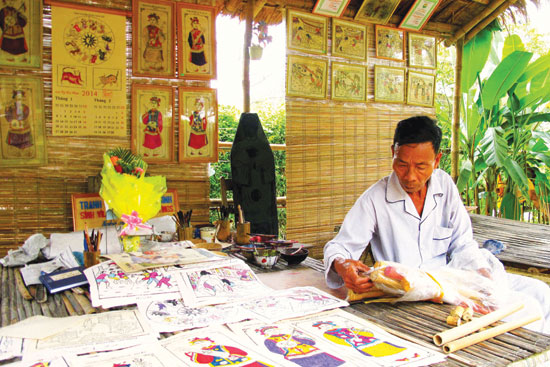No 3, Vol.6, May – June 2015

Artisan Ky Huu Phuoc at his workshop in the village. Photo: Bao Huy
The love of one man for the craftsmanship of a traditional village located in the outskirts of Hue has yielded strong attention from tourists visiting the country’s former imperial capital city, who regard the ritual craft as art.
Ky Huu Phuoc, a resident of the village that has long been known for its votive paper paintings, wants his craft to have wider fame outside its ritual use.
Phuoc began his creation in 2006 and the increasing number of foreign visitors approaching his workshop in the village proves the effort to build on a foundation of tradition has been worth it. Phuoc’s workshop has become a destination for unique countryside traditional craft among tour programmes in Hue, said Bao Huy, a local guide.
According to Phuoc, the village’s craft was hibernating for a long time, ever since the cultural authorities put the ritual paper painting on the list of superstitions and its production was prohibited.
‘We experienced a very tough time; the villagers had to bury the woodblock and tools to avoid destroying them. The preservation of our ancestral craft has been fortunate so far,’ says Phuoc.
‘But the painful experience drives me strongly to make the craft an art form, which helps it to get broader fame as well as stand outside from any possible allegation of superstition,’ he said.
Originally, the paper painting products from the village served in the custom of burning votive paper offerings. The village also produces paper paintings used for worshiping of Mau (Mother), who is said to be a home god guarding lives of women in every family.
Artisans at the village use a woodblock with carved patterns to put black ink on a sheet of paper, on which they will add colours, depending on the votive purposes. Ink and colours are extracted from vang (sappan wood) tree and several other wild plants.

Sinh village painting fearturing postures in wrestling. Photo: Ha Nguyen
The burning of votive items includes substituting paper paintings inked with pigs, cows, buffalos, to wish for good husbandry, or with ancient coins, for the wish of prosperity, or even with humans, for sacred rituals.
Practicing his craft since the age of 10, the 66-year-old Phuoc is an expert in all the techniques, from carving the woodblocks to making ink and colours, which inspired him to combine tradition with creation.
The first application of that resulted in the paintings of wrestlers. The Sinh village is also well-known for its traditional wrestling bout, held on the 10th day of every lunar New Year.
‘The paintings depicting wrestlers carry my double happiness, as it reflects two prominent sides of my village,’ says Phuoc.
At first, Phuoc worked with artists from the Hue College of Arts and artist Than Van Huy, who is a painter and an artisan who makes paper lotus flowers in neighbouring Thanh Tien village, for drawings on wooden plates.
He then carved the drawings of wrestlers’ kneeling and standing gestures for woodblocks for the paper paintings, just as in local tradition. Phuoc uses industrial paints instead of traditional ink, due to the shortage of ink materials.
The collection of wrestler paintings gained much applause from people who love folklore art and from foreign visitors, who buy the paintings as a local unique gift item.
Following his success, Phuoc began to produce wall calendars printed with the 12 Oriental zodiac animals in 2010.
With similar approaches, Phuoc copied the zodiac animal drawings on woodblocks that he inherited from his ancestors to make his own blocks. Calendars are quite popular in Vietnam, for wall decoration. Many in Hue favour calendars made by Phuoc, as they have a nostalgic look about them.
‘The strongest demand for the calendars comes from Hanoi when new year is near. Sometimes I have to refuse some of their orders,’ says Phuoc, reaffirming that he has an urge to make the products, to get more people know about his village’s craft.
Another creation by Phuoc on the craft is the painting of ladies with Vietnamese traditional music instruments, including dan nhi (two-string vertical violin), dan tranh (long zither), dan nguyet (moon lute) and dan bau (monochord zither).
In the paintings, the ladies with smiling round faces dressed in colourful traditional costumes give a very charming look, thus many purchase the painting for home decoration.
Last year, Phuoc went further on the road of renewing his village’s craft village, issuing a collection of farmers on rice paddies. The paintings feature the farmers ploughing with a buffalo, planting rice and harvesting.
The collection has earned much acclaim. However, experts have pointed out that Phuoc has been less than clever and has basic shortcomings in knowledge.
According to Phuoc, he added more musical instruments into the original bat am (eight tune) paintings, which were in a traditional paper painting collection of ladies with four instrument items used for votive purpose. ‘Bat means eight, but I found in the heritage woodblocks only four instrument items, so I added four more, including the drum,’ he says.
‘Bat am is for tune, not for musical instrument items, so adding the wrong instrument ruins the theme of original paintings of the village,’ says culture researcher Ho Tan Phan.
Everyone recognizes that Phuoc wrongly placed a harvesting machine in the new collection of farmers at work. Phuoc admits the mistake and pledges to replace that with a woodblock carving showing the ancient method of rice harvesting.
Despite the mistakes, people welcome Phuoc’s innovative attempts. The mistakes could be seen as part of folklore art, as it reflects the innocent characteristic of a farmer, which best describes Phuoc, as researcher Phan says.n

